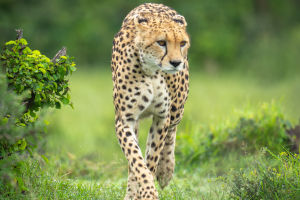Color Shifters
Have you ever wondered how some animals seem to magically change their colors to blend into their surroundings or warn predators? This incredible ability to shift color is not just for beauty—it is a vital survival tool.
In this article, we explore how various animals use color change to adapt, protect themselves, and thrive in the wild. Let's dive into the fascinating world of color-shifting creatures!
The Science Behind Color Change
Color change in animals happens through specialized cells called chromatophores, which contain pigments and reflect light differently. When these cells expand or contract, the animal's visible color shifts. Some species, like chameleons, can rapidly change color within seconds, while others, such as certain fish and reptiles, do so more gradually.
This adaptation allows animals to respond to environmental cues like temperature, light, or emotional state.
Camouflage: Blending with the Environment
One of the most common reasons animals change color is for camouflage. Arctic animals, such as the snowshoe hare, turn white in winter to blend with the snow and brown in summer to match the earth and vegetation.
Similarly, flatfish on the ocean floor adjust their colors and patterns to match the seafloor, making them nearly invisible to predators and prey. This ability to hide in plain sight greatly increases their chances of survival.
Communication and Warning Signals
Color changes are also used to send signals to other animals. Some frogs and fish display brighter colors when threatened to warn predators they are poisonous or dangerous. For example, the cuttlefish flashes vibrant patterns during mating or when feeling threatened, communicating with others in its environment.
These visual signals can prevent conflicts or help animals find mates.
Temperature and Mood Indicators
In addition to survival strategies, color change can reflect an animal's internal state. Chameleons often change color not only to camouflage but also to regulate body temperature or express emotions like aggression or calmness. Darker colors absorb more heat, helping the animal warm up, while lighter colors reflect sunlight to cool down.
This multifunctional use of color shows how complex and intelligent these animals can be.
Examples of Remarkable Color Shifters
Some of the most impressive color-changing animals include:
• The chameleon, famous for its rapid color transformations.
• The mimic octopus, which changes color and shape to imitate other sea creatures.
• The flounder, a flatfish that blends with sandy or rocky ocean floors.
• The arctic fox, which switches from white to brown fur seasonally.
Each of these animals has evolved unique methods to survive in their particular habitats, demonstrating nature's creativity.
How Color Change Benefits Survival
Changing color can protect animals from predators, improve hunting success, help regulate body temperature, and facilitate social interaction. For animals living in extreme or changing environments, this flexibility is essential. It helps them avoid dangers and seize opportunities, increasing their chances of reproducing and passing on their genes.
Scientific Research and Future Discoveries
Scientists continue to study the mechanisms behind animal color change, uncovering insights into genetics, biochemistry, and ecology. Research on chromatophores may even inspire new technologies in materials science, such as camouflage clothing or dynamic displays.
Understanding these natural processes highlights the interconnectedness of life and innovation.
Conclusion: The Marvel of Adaptation
Next time you spot an animal that seems to change color before your eyes, remember it's not just a trick of nature—it's a powerful survival skill honed over millions of years. These incredible color shifters teach us about adaptability, resilience, and the beauty of life's diversity. What color changes have you noticed in animals around you?
Share your observations and keep exploring the wonders of nature!
-
 Speed SecretsWhat Makes Cheetahs the Fastest Land Animals? Discover Their Unique Body Features and Hunting Strategies!
Speed SecretsWhat Makes Cheetahs the Fastest Land Animals? Discover Their Unique Body Features and Hunting Strategies! -
 Why Cats Sleep So MuchDiscover your cat's sleep habits and how to create a perfect rest space!
Why Cats Sleep So MuchDiscover your cat's sleep habits and how to create a perfect rest space! -
 Birds Navigate Long JourneysDiscover the remarkable ways birds use magnetic fields, stars, and the sun for migration.
Birds Navigate Long JourneysDiscover the remarkable ways birds use magnetic fields, stars, and the sun for migration.
Contact to : xyjph123@gmail.com
Privacy Agreement
Copyright © boyuanhulian 2020 - 2022. All Right Reserved.
Privacy Agreement
Copyright © boyuanhulian 2020 - 2022. All Right Reserved.